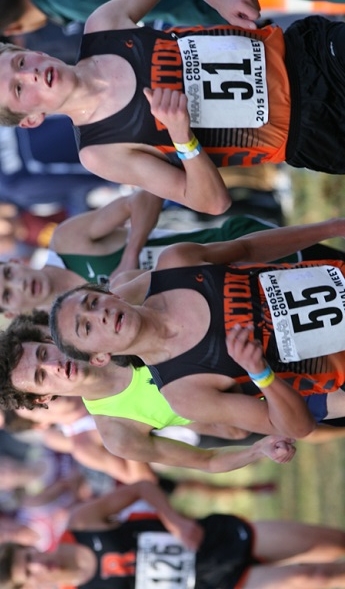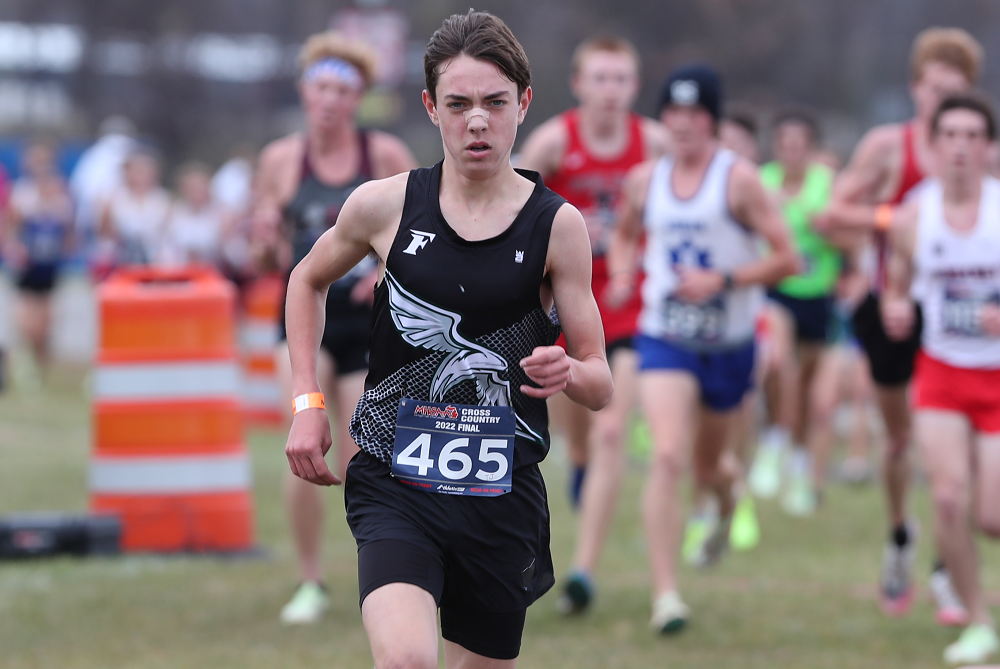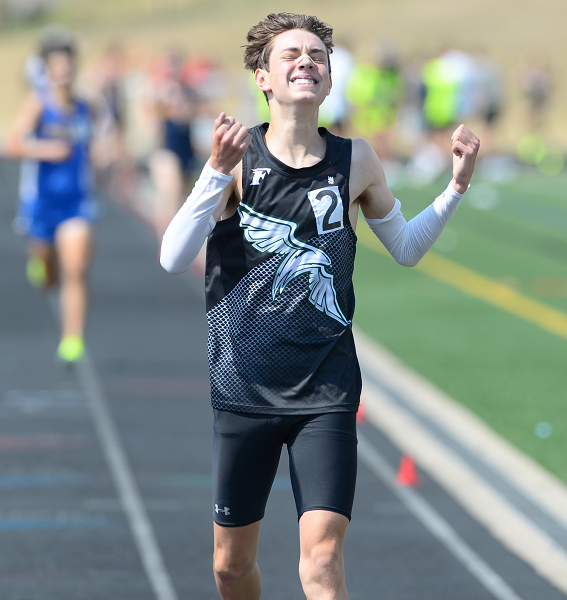
Dimambro Moves to Front of Fenton Pack
August 17, 2016
By Bill Khan
Special for Second Half
FENTON — Dominic Dimambro was the little kid who often tagged along with his older brother and his friends.
 "When we were on the team, he was almost like a team mascot of sorts," said Fenton cross country coach Jesse Anderson, who ran for the Tigers from 2003-06. "We were able to pull out pictures of him out at cross country camp the first or second year he was running. I was on the team with his older brother, Joe. He's been around the running culture for a long time. He's always been very athletic. He's a kid who was able to breakdance and spin on his head when he was 4 years old, so that kept us entertained."
"When we were on the team, he was almost like a team mascot of sorts," said Fenton cross country coach Jesse Anderson, who ran for the Tigers from 2003-06. "We were able to pull out pictures of him out at cross country camp the first or second year he was running. I was on the team with his older brother, Joe. He's been around the running culture for a long time. He's always been very athletic. He's a kid who was able to breakdance and spin on his head when he was 4 years old, so that kept us entertained."
Ten years after Joe Dimambro and Anderson helped put Fenton on the state cross country map, the kid who used to be a source of amusement for the older boys is now the high school senior who has his sights set on big brother's school records.
Joe Dimambro, who went on to run at Michigan State University, holds Fenton's records in cross country (15:24.9 at the 2006 Portage Invitational) and 1,600-meter run (4:12.88 at the 2007 Midwest Meet of Champions). Dominic Dimambro's career bests are 15:48.5, which was good for a 23rd-place finish in last year's MHSAA Division 1 Lower Peninsula cross country meet, and 4:22.67 in the 1,600 from the Regional meet last spring. He went on to place 12th in the MHSAA LP Division 1 LP track and field meet in 4:23.43.
"He's always been coaching me and encouraging me," Dominic said of his older brother. "He wants me to go beyond what he did, so it's a friendly rivalry."
A decade ago, Anderson was a teammate who helped push Joe Dimambro to those school records. Now, he's a second-year coach who could help Dominic break two of the most impressive school records in the Flint area.
"It's great," Dominic said. "He's like a life-long friend of mine. He was friends with my brother growing up. I get to see a lot of him. I get him here at cross country. He's my boss at Red Fox (Outfitters, a Fenton athletic shoe and outdoor gear store). He's been my friend for life. He has a lot of running knowledge. He does a great job with everybody, not just the fast guys – everybody."
And there's one aspect of Anderson's training philosophy that Dominic particularly appreciates — the emphasis on keeping runners healthy.
"He's really done a great job," Dimambro said. "One thing that's been really good is injury prevention. We've had close to no injuries the past two years. He's helped us a lot."
That emphasis hits close to home for Dimambro, because his sophomore year of cross country and track was decimated because of an injury, then an illness. A problem with a nerve in his right leg shut down his 2014 cross country season after only four meets. His fastest time that season was 16:29.2, a time he eclipsed six times as a freshman, with a personal best of 16:17.6.
It was a devastating season for a runner who was the top freshman at the 2013 MHSAA Division 1 LP meet, placing 52nd in 16:24.5. He had to take six months off from running, smack in the middle of a promising high school career.
Once he returned to running, a bout of mononucleosis limited him to four meets the following track season. His best time that spring (4:42.37) was nearly 12 seconds slower than his best as a freshman (4:30.7).
"I was not happy during that time," Dimambro said. "It was really frustrating to see a couple of seasons slip through your hands. For a while, I didn't know if I'd come back to running. I'm really involved in the music program. I thought maybe I'll just stick with that. Now, I use it as encouragement, because I'm back in it and it's all the more reason to do better in the future."
One source of encouragement for Dimambro as he battled through that period was a group of fast running friends that included former teammate Jacob Lee, current teammate Andrew Bond and 2015 Grand Blanc graduate Grant Fisher. Lee was the MHSAA Division 1 LP champion in the 3,200 in 2016, Bond joined Lee and Dimambro on the all-state podium at last year's Cross Country Finals, and Fisher is a two-time national Foot Locker cross country champion who made All-America as a freshman at Stanford University.
"They helped me a lot get back on my feet after my injury," Dimambro said. "Just seeing the times they're posting and encouraging me. They're like, 'You've got to get back into it. You can be right there. You just have to spend some time getting back into it.' They're good training partners and also great friends of mine."
 High school runners of Dimambro's caliber don't often have teammates who can keep up with them in workouts. He was blessed last season to have two teammates who could push him in practice and in meets.
High school runners of Dimambro's caliber don't often have teammates who can keep up with them in workouts. He was blessed last season to have two teammates who could push him in practice and in meets.
At the Division 1 Cross Country Finals, Fenton had three all-state runners who were separated by only seven places and 4.9 seconds. Lee was 19th in 15:46.6, Dimambro 23rd in 15:48.5 and Bond 26th in 15:51.5 to lead the team to a ninth-place team finish. Dimambro and Bond are senior co-captains this year.
"It's always great to have people the same caliber all running together," Dimambro said. "When you have a bunch of other people you're training with, everybody else around you is going to push you. Having a bunch of guys running around the same time is good for the team. Last year, we had a lot of guys running around 18:30. Originally, they were around 20 minutes, but they were pushing each other in practice. No one wants to be the one losing to the others."
For all of Dimambro's accomplishments, he's never won a cross country race in high school. That will happen when you run for three years on a team led by someone like Lee, who now runs for the University of Michigan.
Dimambro had eight top-five finishes last year, with a second place to Lee in the Flint Metro League meet his best. He was third in the Regional behind eventual Division 1 Finals runner-up Mitchell Day of Alpena (now a senior) and Lee.
"I've always just been kind of like Jake's shadow in those races where we'd go 1-2," Dimambro said. "It'll be a little different this year. I wouldn't count out Andrew. He's in phenomenal shape. That kid's fit."
Anderson said he doesn't try to project a goal finish for Dimambro at the MHSAA Finals, because that can be dependent on other runners. He tries to get his runners to control what they can control.
"Our goal for him is to get an underlying strength that he can respond to different stresses in races later on in the year," Anderson said. "He's one of the smarter racers you'll encounter at the high school level. If he's in a pack of people in the same shape as him, I'll take him nine times out of 10. He's very tough and very smart."
Having two returning all-staters at the top of its lineup bodes well for Fenton, which won the Regional championship in Anderson's first season last fall. The Tigers ran in a Regional hosted by Bay City Western last year, but move to one hosted closer to home at Linden this season.
It's a Regional that includes White Lake Lakeland and Milford, two perennial powers who finished among the top seven in last year's Division 1 Finals meet. The top three teams from Regionals qualify for the MHSAA Finals.
"We've got our work cut out for us, but that's why we're here in the morning in the summer to take it day by day," Anderson said. "We'll worry about them when we get in a race."
 Bill Khan served as a sportswriter at The Flint Journal from 1981-2011 and currently contributes to the State Champs! Sports Network. He can be reached at [email protected] with story ideas for Genesee, Lapeer, St. Clair, Sanilac, Huron, Tuscola, Saginaw, Bay, Arenac, Midland and Gladwin counties.
Bill Khan served as a sportswriter at The Flint Journal from 1981-2011 and currently contributes to the State Champs! Sports Network. He can be reached at [email protected] with story ideas for Genesee, Lapeer, St. Clair, Sanilac, Huron, Tuscola, Saginaw, Bay, Arenac, Midland and Gladwin counties.
PHOTOS: (Top) Dominic Dimambro (55), flanked by teammate Andrew Bond (51), moves ahead in the pack during last season's Division 1 Cross Country Finals. (Middle) Dimambro works to stay ahead of a Northville runner during this spring's Division 1 Track & Field Finals. (Top photo by Carter Sherline/RunMichigan.com; middle photo by Bill Khan.)

Freeland's Hansen Not Focused on Joining All-Time Greats - But On His Way
By
Paul Costanzo
Special for MHSAA.com
September 29, 2023
The goal written on Matt Kaczor’s Post-It Note was sub-15 minutes, 15 seconds. That’s what the Freeland cross country coach was hoping for from star runner TJ Hansen during his junior season.
 Kaczor tore it up after seeing Hansen run a single race this fall.
Kaczor tore it up after seeing Hansen run a single race this fall.
“Knowing what he did over the summer and where he was at, seeing what his 1,600 (meter) and his mile got down to, I had a feeling he could get under 15:30 quickly,” Kaczor said. “After the first race, I looked at my assistant and was like, ‘I’ve gotta rip up that Post-It Note. I don’t think our goal is on the level of where he’s at right now.’ At first, it was break 15:15. Once I saw him race at the Under the Lights (on Aug. 18 at St. Johns), I was like, ‘Yeah, he’s going sub 15.’”
Hansen ran 15:39.6 in that first race, and on Sept. 7, in Shepherd, he ran 15:13.9 to meet the goal written on the now-shredded Post-It Note.
This past Saturday, he ran 15:03.7 at the Cadillac Veterans Serving Veterans Invitational. It’s the fastest time recorded in Michigan this year, and a signal that Kaczor might be filling out a new Post-It Note before the season is out.
“The sub-15 barrier, that’s been something on my mind for a while,” Hansen said. “Now that I’m edging closer and closer to that, it’s been exciting. With how heavy my training has been, I wouldn’t expect (to have run this fast this early). Being able to run the times I am really paints the picture for what’s ahead.”
Hansen came into the season already regarded as one of the elite distance runners in the state. He won the 3,200 meters at the MHSAA Lower Peninsula Division 2 Track & Field Finals this past spring. He’s also finished all-state (12th and fifth, respectively) the past two seasons at the LPD2 Cross Country Finals.
His current trajectory, however, would put his name near some of the state’s all-time greats. But that’s not something Hansen is focusing on.
“I really don’t like to compare myself to others,” he said. “I don’t focus on that. I try to be the best TJ Hansen that I can be. The best version of myself.”
Focusing on himself is almost necessary for Hansen, as he’s spending a lot of time during his races running by himself.
At each of the big events Freeland has run in this season, Hansen has finished at least 20 seconds ahead of his nearest competitor. That includes all divisions of the Duane Raffin Festival of Races in Holly.
In Cadillac, where Hansen ran his current best time, he was a full minute ahead of the rest of the field.
 “He’s just a special athlete,” Kaczor said. “I can’t see Freeland having someone like this in a while. He’s a generational talent. What’s crazy is, I had the school record when he was a freshman. He and Braden (Honsinger) broke it last year. But TJ has now dropped that school record (set in 1998) by almost a minute.”
“He’s just a special athlete,” Kaczor said. “I can’t see Freeland having someone like this in a while. He’s a generational talent. What’s crazy is, I had the school record when he was a freshman. He and Braden (Honsinger) broke it last year. But TJ has now dropped that school record (set in 1998) by almost a minute.”
Hansen’s achievements have already put him on a path to run at the next level, which is something of a family tradition.
His older sisters Peyton and Kiera are track & field athletes at Wayne State and Eastern Michigan, respectively. Their parents, Tim and Pam, were track & field stars at Central Michigan.
TJ has drawn the attention of coaches around the country, including from Michigan, Michigan State, Wisconsin, Tennessee and Colorado.
Having family members who know the process is a help for Hansen, and he said they’ve all been good about allowing him to choose his own path, whatever that may be.
“He’s from a good family that knows how to work and knows how to get things done,” Kaczor said. “He knows that if he puts in the work, he’s going to be at a good spot.”
While Hansen admits it can be a bit overwhelming, he’s using it as motivation to run faster and continue to put his name out there.
Also serving as motivation is 2022 Division 2 champion Connell Alford of Chelsea. Alford is among the elite group of runners in Michigan who have broken the 15-minute mark, doing it twice a year ago.
He currently has the state’s second-best time behind Hansen’s this year, running 15:09.1 at the MSU Invitational on Sept. 15.
“Whenever I see him drop a time, my main goal is to run faster,” Hansen said. “Whenever I see him run a good time, that motivates me to work hard.”
The two won’t see each other until the MHSAA Finals on Nov. 4 at Michigan International Speedway. It’s an opportunity Hansen is excited for, as it’s a chance to race and be pushed toward the lofty goals he’s set for himself. Kaczor is excited about it, too, even if it might mean having to replenish his supply of Post-Its.
“We don’t talk about winning the state title; we talk about making sure that we have great races on those days,” Kaczor said. “We can’t control how somebody else runs. It’s a matter of can we, if the weather is right and the course is in good condition, can we be one of the few guys that has run in the 14s on that course? That’s the goal. Put yourself in some great categories with those upper echelons and the greats of all-time.”
 Paul Costanzo served as a sportswriter at The Port Huron Times Herald from 2006-15, including three years as lead sportswriter, and prior to that as sports editor at the Hillsdale Daily News from 2005-06. He can be reached at [email protected] with story ideas for Genesee, Lapeer, St. Clair, Sanilac, Huron, Tuscola, Saginaw, Bay, Arenac, Midland and Gladwin counties.
Paul Costanzo served as a sportswriter at The Port Huron Times Herald from 2006-15, including three years as lead sportswriter, and prior to that as sports editor at the Hillsdale Daily News from 2005-06. He can be reached at [email protected] with story ideas for Genesee, Lapeer, St. Clair, Sanilac, Huron, Tuscola, Saginaw, Bay, Arenac, Midland and Gladwin counties.
PHOTOS (Top) Freeland's TJ Hansen leads a pack during last season's LPD2 Final at Michigan International Speedway. (Middle) Hansen enjoys a moment of exhilaration after winning the 3,200 this spring at the LPD2 Finals at Ada Forest Hills Eastern. (Top photo by Carter Sherline/Run Michigan; middle photo by Dave McCauley/Run Michigan.)

